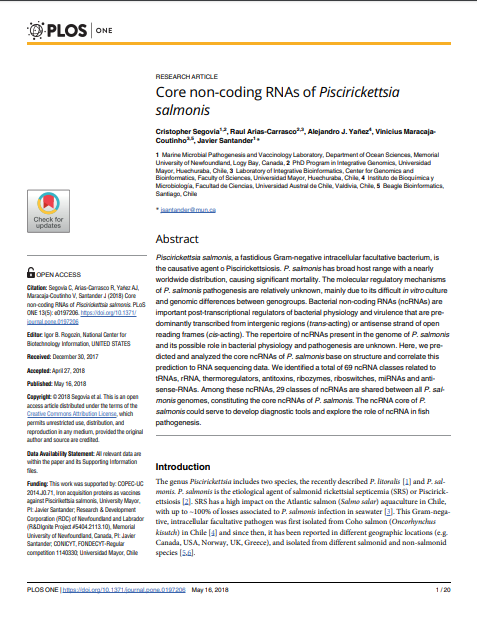Core non-coding RNAs of Piscirickettsia salmonis

Fecha
2018Autor
Arias-Carrasco, Raúl [Univ Mayor, Fac Ciencias, Ctr Genom & Bioinformat, Santiago, Chile]
Maracaja-Coutinho, Vinicius [Univ Mayor, Fac Ciencias, Ctr Genom & Bioinformat, Santiago, Chile]
Segovia, Cristopher [Univ Mayor, PhD Program Integrat Genom, Huechuraba, Chile]
Yañez, Alejandro J.
Santander, Javier
Ubicación geográfica
Notas
HERRAMIENTAS
Acceda a títulos restringidos
¿Cómo descargar?Resumen
Piscirickettsia salmonis, a fastidious Gram-negative intracellular facultative bacterium, is the causative agent o Piscirickettsiosis. P. salmonis has broad host range with a nearly worldwide distribution, causing significant mortality. The molecular regulatory mechanisms of P. salmonis pathogenesis are relatively unknown, mainly due to its difficult in vitro culture and genomic differences between genogroups. Bacterial non-coding RNAs (ncRNAs) are important post-transcriptional regulators of bacterial physiology and virulence that are predominantly transcribed from intergenic regions (trans-acting) or antisense strand of open reading frames (cis-acting). The repertoire of ncRNAs present in the genome of P. salmonis and its possible role in bacterial physiology and pathogenesis are unknown. Here, we predicted and analyzed the core ncRNAs of P. salmonis base on structure and correlate this prediction to RNA sequencing data. We identified a total of 69 ncRNA classes related to tRNAs, rRNA, thermoregulators, antitoxins, ribozymes, riboswitches, miRNAs and antisense-RNAs. Among these ncRNAs, 29 classes of ncRNAs are shared between all P. salmonis genomes, constituting the core ncRNAs of P. salmonis. The ncRNA core of P. salmonis could serve to develop diagnostic tools and explore the role of ncRNA in fish pathogenesis.
URI
https://doi.org/10.1371/journal.pone.0197206http://repositorio.umayor.cl/xmlui/handle/sibum/6199
Coleccion/es a la/s que pertenece:
Si usted es autor(a) de este documento y NO desea que su publicación tenga acceso público en este repositorio, por favor complete el formulario aquí.